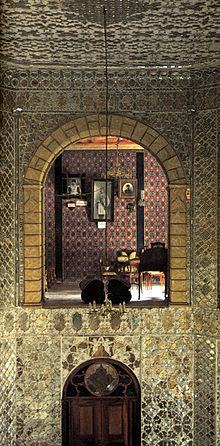| Revision as of 16:03, 25 October 2007 editAlleborgoBot (talk | contribs)94,853 editsm robot Adding: tg:Мокӯ← Previous edit | Revision as of 13:53, 23 November 2007 edit undoMalikbek (talk | contribs)Extended confirmed users3,749 editsNo edit summaryNext edit → | ||
| Line 4: | Line 4: | ||
| {{coor title dms|39|17|24|N|44|28|08|E|region:IR_type:city(41513)_source:dewiki}} | {{coor title dms|39|17|24|N|44|28|08|E|region:IR_type:city(41513)_source:dewiki}} | ||
| '''Maku''' also spelled '''Makou''' and Maki (in Turkish)is a town in the northwestern part of the ] province of ]. It is situated 22 km from the Turkish border in a mountain gorge at an altitude of 1634 metres. The ] cuts through the city<ref name="Bridge"></ref><ref></ref>. | '''Maku''' also spelled '''Makou''' and Maki (in Turkish) is a town in the northwestern part of the ] province of ]. It is situated 22 km from the Turkish border in a mountain gorge at an altitude of 1634 metres. The ] cuts through the city<ref name="Bridge"></ref><ref></ref>. | ||
| ==Etymology== | ==Etymology== | ||
| Line 12: | Line 12: | ||
| == History == | == History == | ||
| Maku was one of |
Maku was the capital of a ]<ref>http://www.worldstatesmen.org/Iran.htm</ref> one of numerous small, semi-independent ] that resulted from the breakup of the ] empire in the 17th century.<ref> unsourced history</ref> | ||
| The city is well-known in ] history for its fort where the ] had been exiled to and imprisoned for nine months. In this fortress ], the first ] of the ] had the chance to meet his Master again, arriving on ] of the year ]. | The city is well-known in ] history for its fort where the ] had been exiled to and imprisoned for nine months. In this fortress ], the first ] of the ] had the chance to meet his Master again, arriving on ] of the year ]. | ||
Revision as of 13:53, 23 November 2007


39°17′24″N 44°28′08″E / 39.29000°N 44.46889°E / 39.29000; 44.46889
Maku also spelled Makou and Maki (in Turkish) is a town in the northwestern part of the West Azerbaijan province of Iran. It is situated 22 km from the Turkish border in a mountain gorge at an altitude of 1634 metres. The Zangmar River cuts through the city.
Etymology
According to some accounts the word Maku possibly derives from the armenian language Maki.
History
Maku was the capital of a Kangarli Khanate one of numerous small, semi-independent Khanates that resulted from the breakup of the Safavid empire in the 17th century.
The city is well-known in Bahá'í history for its fort where the Báb had been exiled to and imprisoned for nine months. In this fortress Mullá Husayn-i-Bushru'i, the first Disciple of the Báb had the chance to meet his Master again, arriving on Náw-Rúz of the year 1848.
In ancient times the region of Maku was a part of Lesser Media and its name itself may be derived from the Persian word Madkuh meaning "the Mountain of the Medes". Medes were one of the ancient Iranian tribes.
Population
The city's population is comprised mostly of Azeris and Kurds.Encyclopedia Iranica notes Maku as the home of Qara Qoyunlu Azeris The Office of West Azerbaijan's Governor also verifies this. Maku had an Armenian majority before World War I.
Attractions
- Baqcheh Jooq Palace: dates back to the end of the Qajar period. It used to be the house of the local governor until 1974. Presently it functions as a museum with some carpets and local handicrafts.
- Ruins of a fort also used as a border post.
- Hiking : it is advisable to have a guide or stay within eye-sight of the town. Due to its proximity to the Turkish border, it is easy to cross the border unintentionally.
- Rock climbing: There are numerous rock climbing sites at the northern part of the city, some exceeding 200 meters.
- Panj Cheshmeh - This bridge is located 5 km. from Maku on the Zangmar River, and is a monument from the Safavid era. This bridge was constructed in order to facilitate communications between Tabriz and Maku, and the surrounding rural areas.
Notes
- ^ "Pol-e Panj Cheshmeh (Five spans bridge)" Gardesh Yaran International Tour Operator Co.
- Satellite view
- http://www.worldstatesmen.org/Iran.htm
- Imranova, K. and Bayramov, E. "Historical formation of the Azerbaijani political culture and national consciousness" Azerigenocide.org unsourced history
- Encyclopedia Iranica. p235, also see Oberling. p62.
References
- P. Oberling, The Turkic Peoples of Iranian Azerbaijan, 1964a, American Council of Learned Scientists